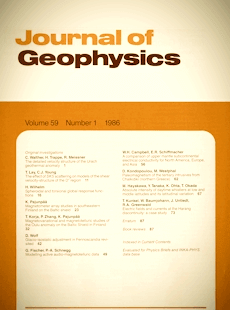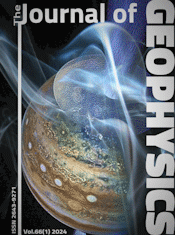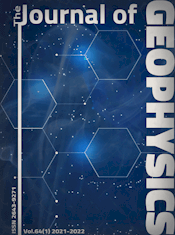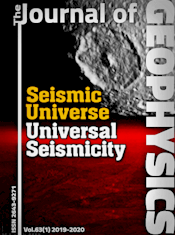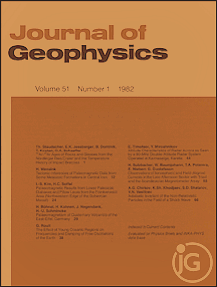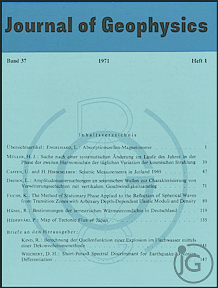Absolute intensity of daytime whistlers at low and middle latitudes and its latitudinal variation
Article Sidebar
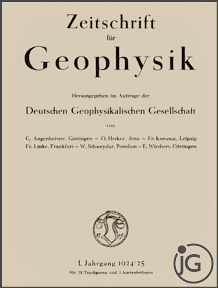
Vols. 1-18 (1924-1944), ISSN 0044-2801
Main Article Content
Abstract
The statistical study on the field intensity of daytime whistlers at low (geomag. lat. 25°) and middle (35°) latitudes has been made, based on a lot of data obtained by the field-analysis direction finding system based on the simultaneous measurement of two horizontal magnetic field components and one vertical electric field component. At low latitude, the maximum absolute intensity is estimated to be 250 μV/m, while the corresponding maximum intensity at middle latitude amounts to 600 μV/m, being about 2.4 times that at low latitude. This latitudinal variation of daytime intensity is interpreted in terms of the joint influence of (a) source activity, (b) magnetospheric propagation effect and (c) ionospheric transmission loss. As the result, it is found that whistlers at each station are attributed to ducted propagation in the magnetosphere and have exited the ionosphere close to each observing station, as determined by the direction finding results. Furthermore, the cloud distributions observed by meteorological satellites have yielded that the duct entrance point of whistlers at each station fall within the active thunderstorm region. Hence, we can conclude that daytime whistlers are originated in the active thunderstorms in each conjugate region, are trapped in field-aligned ducts and followed by nearly the vertical exit from the ionosphere at each station. Finally the latitudinal difference of the intensity is satisfactorily interpreted in terms of the difference in the ionospheric transmission loss on the assumption of the same source intensity at each conjugate point and of no amplification in the magnetosphere.
 ARK: https://n2t.net/ark:/88439/y007596
ARK: https://n2t.net/ark:/88439/y007596
Permalink: https://geophysicsjournal.com/article/230
Article Details
References
Carpenter, D.L. (1980): Fast fluctuations in the arrival bearing of magnetospherically propagating signals from the Siple, Antarctica. J. Geophys. Res. 85:4157-4166
Carpenter, D.L., LaBelle, J.W. (1982) A study of whistlers correlated with bursts of electron precipitation near L = 2. J. Geophys. Res. 87:4427-4434
Cousins, M. (1972) Direction finding on whistlers and related VLF signals. Tech. Rep. SEL-72-013, Radioscience Lab., Stanford Univ.
Hayakawa, M., Ohtsu, J., Iwai, A. (1969) Occurrence rate and dispersion of whistlers during magnetically disturbed periods at lower latitudes. Rep. Ionosph. Space Res. Japan 23:9-20
Hayakawa, M., Tanaka, Y. (1978) On the propagation of low latitude whistlers. Rev. Geophys. Space Phys. 16:111-123
Hayakawa, M., Okada, T., Iwai, A. (1981a) Direction findings ofmediumlatitude whistlers and their propagation mechanism. J. Geophys. Res. 86:6939-6946
Hayakawa, M., Tanaka, Y., Okada, T., Iwai, A. (1981b) Goniometric direction finding for low-latitude whistlers and their propagation characteristics. J. Geophys. Res. 86:6781-6793
Hayakawa, M., Tanaka, Y., Okada, T., Ohtsu, J. (1983) Time scales of formation, lifetime and decay of whistler ducts at low latitudes. Ann. Geophysicae 1:515-518
Hayakawa, M., Ohta, K., Tanaka, Y. (1985) Further direction finding evidence on ducted propagation of low-latitude daytime whistlers and the duct structure To be published in Res. Lett. Atmosph. Electr.
Helliwell, R.A. (1965) Whistlers and Related Ionospheric Phenomena, p. 124. Stanford University Press
Helliwell, R.A., Katsufrakis, J.P., Trimpi, M.L. (1973) Whistler induced amplitude perturbation in VLF propagation. J. Geophys. Res. 78:4679-4688
Iwai, A., Outsu, J. (1958) On an investigation of the field intensity of whistling atmospherics. Proc. Res. Inst. Atmos., Nagoya Univ. 5:50-52
Leavitt, M.K., Carpenter, D.L., Seely, N.T., Padden, R.R., Doolittle, J.H. (1978) Initial results from a tracking direction finding receiver for whistler mode signals. J. Geophys. Res. 83:1601-1610
Lester, M., Smith, A.J. (1980) Whistler duct structure and formation. Planet. Space Sci. 28:645-654
Lohrey, B., Kaiser, A.B. (1979) Whistler induced anomalies in VLF propagation. J. Geophys. Res. 84:5121-5130
Matthews, J.P., Smith, A.J., Smith, I.D. (1979) A remote unmanned ELF/VLF goniometer receiver in Antarctica. Planet. Space Sci. 27:1391-1401
Ohta, K., Hayakawa, M., Tanaka, Y. (1984) Ducted propagation of daytime whistlers at low latitudes as deduced from the groundbased direction finding. J. Geophys. Res. 89:7557-7564
Okada, T., Iwai, A., Hayakawa, M. (1977) The measurement of incident and azimuthal angles and the polarization of whistlers at low latitudes. Planet. Space Sci. 25:233-241
Okada, T., Iwai, A. (1980) A new device for measuring polarization and field intensity of low-latitude whistlers. Trans. Inst. Electr. Engrs. Japan 100:21-28
Okada, T., Iwai, A., Hayakawa, M. (1981) A new whistler direction finder. J. Atmos. Terr. Phys. 43:679-691
Pitteway, M.L.V., Jespersen, J.L. (1966) A numerical study of the excitation, internal reflection and limiting polarization of whistler waves in the ionosphere. J. Atmos. Terr. Phys. 28:17-43
Sagredo, J.L., Bullough, K. (1973) VLF goniometer observations at Halley Bay, Antarctica, II. Magnetospheric structure deduced from whistler observation. Plant. Space. Sci. 21:913-923
Strangeways, H.J., Madden, R.A., Rycroft, M.J. (1983) High latitude observation of whistlers using three spaced goniometer receivers. J. Atmos. Terr. Phys. 45:387-399
Tanaka, Y. (1972) VLF hiss observed at Syowa Station, Antarctica, I. Observation of VLF hiss. Proc. Res. Inst. Atmos. Nagoya Univ. 19:33-61
Tanaka, Y., Hayakawa, M. (1973a) The effect of geomagnetic disturbances on duct propagation of low-latitude whistlers. J. Atmos. Terr. Phys. 35:1699-1703
Tanaka, Y., Hayakawa, M. (1973b) Storm-time characteristics of lowlatitude whistlers. Planet. Space Sci. 21:1997
Tanaka, Y., Nishino, M., Hayakawa, M. (1976) A study of VLF auroral hiss observed at Syowa, Antarctica. Mem. Natl Inst. Polar Res., Tokyo, Series A13 (Aeronomy), pp. 58
Tanaka, Y ., Hayakawa, M. (1980) Longitudinal effect in the enhancement of daytime whistler activity at low latitudes. Ann. Geophys. 36:577-585
Taylor, W.L. (1963) Radiation field characteristics of lightning discharges in the band 1 kc/s to 100 kc/s. J. Res. NBS, D. Radio Propagation 67D:539-550
Tsuruda, K., Hayashi, K. (1975) Direction finding technique for ellipitically polarized VLF electromagnetic waves and its application to the low latitude whistlers. J. Atmos. Terr. Phys. 37:1193-1202


